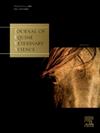Autologous seminal plasma and post-breeding uterine lavage as alternative options to improve fertility rates of jennies inseminated with cryopreserved jack semen
IF 1.6
3区 农林科学
Q2 VETERINARY SCIENCES
引用次数: 0
Abstract
Background
Poor fertility of cryopreserved semen remains a challenge in donkeys.
Aims/objectives
This study evaluated strategies to enhance fertility of cryopreserved semen in donkeys.
Methods
Experiment 1 assessed in vitro parameters of semen cryopreserved with two freezing-semen protocols (BC and mINRA). For evaluation, samples were thawed and split into two aliquots: one served as a control, and the second was re-extended with seminal plasma (SP). Sperm motility, plasma membrane and acrosome integrity (PMAI), lipid peroxidation (LPO), and hydrogen peroxide (H₂O₂) were analyzed. Experiment 2 involved 86 estrous cycles of 33 jennies, inseminated with semen cryopreserved using BC (n = 43 cycles) or mINRA (n = 43 cycles). Each group included control cycles (BC, n = 10; mINRA, n = 10) and three treatments: SP, frozen-thawed semen re-extended in SP (BC, n = 08; mINRA, n = 08); UL, uterine lavage (UL) 10 h post-AI (BC, n = 11; mINRA, n = 11); and SP+UL, frozen-thawed semen re-extended in SP followed by UL 10 h post-AI (BC, n = 14; mINRA, n = 14).
Results
Post-thaw motility was similar between cryopreservation protocols (P > 0.05), but adding SP reduced the motility parameters of cryopreserved semen (P < 0.05). PMAI was higher, and LPO and H2O2 were lower in semen cryopreserved using BC (P < 0.05). Seminal plasma addition did not affect PMAI but reduced LPO and H2O2 (P < 0.05). Pregnancy rates did not differ between semen cryopreserved using BC (21 %) and mINRA (23 %; P > 0.05). The SP+UL-assigned cycles had higher fertility rates (43 %; P = 0.01) compared to control-assigned cycles (0/20), whereas SP- (13 %) and UL-cycles (23 %) had intermediate pregnancy rates (P > 0.05).
Conclusion
Cryopreservation protocol did not impact sperm quality or fertility. However, the association of semen re-extension in SP and post-insemination UL improved fertility outcomes in jennies.
自体精浆和育后子宫灌洗是提高低温保存杰克精液受精珍妮的生育率的替代选择
低温保存的精液生育能力差仍然是驴面临的一个挑战。目的本研究探讨了提高驴冻存精液生育能力的策略。方法实验1对BC和mINRA两种冷冻精液方案的体外参数进行评价。为了评估,将样品解冻并分成两份:一份作为对照,另一份用精浆(SP)重新延长。分析精子活力、质膜和顶体完整性(PMAI)、脂质过氧化(LPO)和过氧化氢(H₂O₂)。实验2选取33只雌性雌性的86个发情周期,分别用BC (n = 43个周期)或mINRA (n = 43个周期)冷冻保存的精液进行受精。每组设对照周期(BC, n = 10;mINRA, n = 10)和三种处理:SP,冻融后的精液在SP中重新延伸(BC, n = 08;mINRA, n = 08);UL, ai后10 h子宫灌洗(UL) (BC, n = 11;mINRA, n = 11);和SP+UL,冻融后的精液在ai后10 h在SP中再延长,然后再延长(BC, n = 14);mINRA, n = 14)。结果两种低温保存方案(P >;0.05),但添加SP降低了冷冻精液的运动参数(P <;0.05)。BC冷冻保存的精液PMAI较高,LPO和H2O2较低(P <;0.05)。精浆添加不影响PMAI,但降低了LPO和H2O2 (P <;0.05)。使用BC(21%)和mINRA(23%)冷冻保存精液的妊娠率没有差异;P比;0.05)。SP+ ul分配周期的生育率较高(43%;P = 0.01),而SP-周期(13%)和ul -周期(23%)的妊娠率中等(P >;0.05)。结论冷冻保存方案不影响精子质量和生育能力。然而,精液再延伸在SP和人工授精后UL的关联改善了女性的生育结果。
本文章由计算机程序翻译,如有差异,请以英文原文为准。
求助全文
约1分钟内获得全文
求助全文
来源期刊

Journal of Equine Veterinary Science
农林科学-兽医学
CiteScore
2.70
自引率
7.70%
发文量
249
审稿时长
77 days
期刊介绍:
Journal of Equine Veterinary Science (JEVS) is an international publication designed for the practicing equine veterinarian, equine researcher, and other equine health care specialist. Published monthly, each issue of JEVS includes original research, reviews, case reports, short communications, and clinical techniques from leaders in the equine veterinary field, covering such topics as laminitis, reproduction, infectious disease, parasitology, behavior, podology, internal medicine, surgery and nutrition.
 求助内容:
求助内容: 应助结果提醒方式:
应助结果提醒方式:


